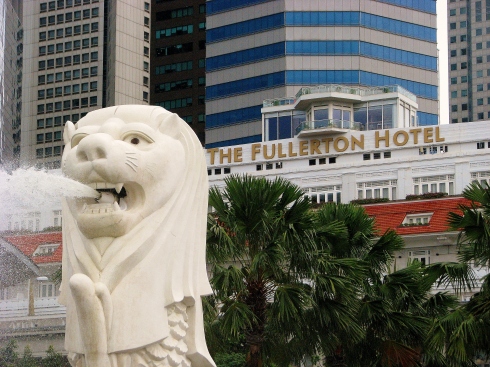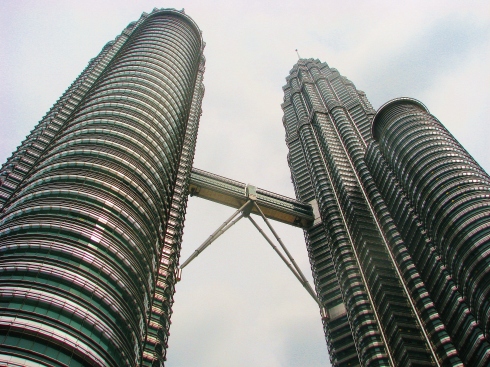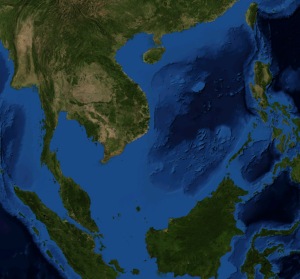For a long time economists, politicians and the world’s media have argued that Asia’s growth since the 1960’s has been driven to a large extent by the Four Asian Tiger Economies; South Korea, Taiwan, Hong Kong & Singapore. Although China and Japan are easily the largest regional economies, it was the ‘miracle’ of these four economies that interested observers. All of these states had export oriented economic policies and strong development policies. As a result they achieved sustained and rapid growth and high levels of equal income distribution, but in 2013 do the Asia Tigers still drive Asia’s growth and do they still have a role to play in making this century the so-called, ‘Asian Century’?
The simple answer is yes. These are still rapidly growing nations that are key cornerstones to regional development but to argue that Asia’s rise is down solely to these four nations is an over-simplicity.

(Above: The Merlion, Singapore’s symbolic representation of the ‘big cat’ ethos within global politics)
China is by far and away the economic and political powerhouse of Asia but close on its heals is India, another of the world’s largest economies, and Japan, who historically had been seen as the leading economy in Asia and, despite recent economic stagnation, is still a powerful global economy. These are the nations that have made Asia an economic and political success. They have ensured Asian representation in leading global organisations, such as the G8 (of which Japan is a member) and BRICS (of which China and Indian are both members) and with China poised to become the world’s largest economy at some point in the near future these will continue to be the nations leading the Asia charge. Some reports have argued that China could overtake the USA in 2016, whereas others argue it will be 2019 and the impact of this change will cement China’s role at the very heart of global politics and economics.
But these nations have always eclipsed the Asian Tigers and so economists have never really considered them when developing the concepts of ‘Tiger States’. The Tiger States have always been seen as the nations coming up behind these huge economies and have been more closely focused on building a society alongside their economy. Although China and Japan may be put to one side there are other nations who are developing on the heels of the Tiger States and who warrant the attention of any interested parties. These nations, known as the Tiger Cub Economies, are seen as the new political powers in Asia and the new markets for investors.
The Tiger Cub’s are Thailand, Malaysia, Indonesia and the Philippines and collectively have shown the shift, within recent times, from the Far East economies to those in South East Asia. All of these nations have followed the successful development of Singapore, just as Hong Kong, South Korea and Taiwan followed the successful development of Japan to become the original Tiger States.
Malaysia, one of the ‘Tiger Cubs’, represents the new wave of economic power in Asia. Its capital, Kuala Lumpur, stands as the glittering centre of economic development, with the Petronas Towers acting as the showpiece for the progress Malaysia has made in recent years. But the towers do not solely represent Malaysia as a new Asian power; they also represent the industries that have driven Malaysian growth. Petronas is the state-owned oil and gas company that has risen to become one of Asia’s most profitable companies and it is this company that has become ubiquitous in Malaysian culture (most recently because of its involvement in Formula 1, sponsoring both the Mercedes GP team and the Malaysia Grand Prix). This company, its towers and the nation who controls it, are all representations of Malaysia’s challenge for pre-dominance in Asia’s economy and like Malaysia the other Tiger Cubs are growing rapidly.
But looking back at the Tiger States themselves we see that although they still sit behind the Asian powerhouses, such as China (they were never going to be rivals to China or Japan’s dominance) they critically stay in front of the Tiger Cub economies. Malaysia may have come a long way but economic power in South East Asia remains firmly in Singapore.
What interests us as academics and as theorists is how these nations cemented their position at the front.
We can split the Tiger States in half to understand their success. Singapore and Hong Kong, being city states, focused on service industries and big business. They became centres of international finance, with stock markets that easily rival the FTSE 100 in London or the Dow Jones in New York. They became the site for business’s Asian and even global headquarters and their understanding of the importance of making international hubs of their respective cities have been critical to their success (there’s a reason that people consistently vote Singapore’s Changi Airport and Hong Kong International as the world’s best airports).
By contrast the larger nations of Taiwan and South Korea have become manufacturing giants. South Korea has easily become the new focus of Asia’s technology boom. Whereas Japanese brands, such as Panasonic, Toyota and Sony, dominated trade in the 1980’s and 90’s they have been surpassed by Korean brands, such as Samsung, HTC, LG and Hyundai which now represents Asian technology globally. Manufacturing has made Seoul, South Korea and Taipei, Taiwan global cities of neon skylines and skyscrapers and their countries destinations for businesses and politicians the world over.
But more than the economics they have used their wealth to bring about real terms social development. They have developed strong education and healthcare systems, have established policies to counteract poverty and they have put many back into the system to improve the quality of life for all their citizens. It is this development of progressive and affluent societies that have marked them out from China’s great economic boom and have ensured that they stay ahead of the competition from the Philippines and Indonesia, who still have a long way to go in the fight against poverty.
These are nations that rose rapidly on the back of the first waves of Asian development and have maintained their position on top of the economic pile, despite competition from new rising powers. They are centres for global trade, symbols of the spread of global capitalism and manufacturing giants that have ensured a global saturation of their brands.
Like the animals they embody they have risen to the top of the economic food chain and although there always might a bigger predator in the region, in the form of China or Japan, Beijing and Tokyo would do well to look behind at the nations stalking their every move.





